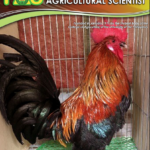Vol. 106, No. 2 (Jun 2023)
PILI NUT (CANARIUM OVATUM ENGL.) CV. MAYON KERNEL. Pili nut is an indigenous crop in the Philippines, widely cultivated in the Bicol region. It is also a rich source of protein and other nutrients. Studies have been made in assessing the health benefits of its oil content, but very few have looked into the bioactivities of its proteins. Gamba et al. (2023) studied the antihypertensive and antioxidative properties of the proteins from the Pili nut kernel. Results showed evidence of higher antihypertensive activity as compared to the conventional antihypertensive drugs with high antioxidative activity. This study is a very significant drug discovery and food supplement development, resulting to high commercial value of the Pili nuts. (https://doi.org/10.62550/RI0610602)
{Photograph courtesy of Ella Gamba, Sorsogon City, Sorsogon}
Categories
Articles
Corn Cob and Corn Husk Biochars Enhance the Growth of Corn (Zea mays L.) in Fertilized Clay Loam Soil
Arsenio D. Bulfa, Jr., Gina Villegas-Pangga, and Amparo M. Wagan
Received: April 29, 2022/ Revised: March 14, 2023/ Accepted: March 22, 2023
(https://doi.org/10.62550/DC042022)
Biochar is a carbon (C) rich material that improves soil quality, increases crop yield, and is produced from biomass pyrolysis under a limited oxygen environment. An experiment laid out in a split-plot, a completely randomized design (CRD) and was conducted to investigate the growth responses of corn-to-corn cob biochar (CCB) (15 t ha-1), and corn husk biochar (CHB) (15 t ha-1) in a Lipa clay loam soil (Typic Eutrudepts) applied with organic fertilizer (OF) (10 t ha-1) and inorganic fertilizer [recommended rate (RR):120 N;60 P2O5-60; K2O per ha]. The results showed that CCB and CHB are rich in macro- and micro-essential elements. The Brunauer-Emmett-Teller (BET) analysis showed the high a...
Biochar is a carbon (C) rich material that improves soil quality, increases crop yield, and is produced from biomass pyrolysis under a limited oxygen environment. An experiment laid out in a split-plot, a completely randomized design (CRD) and was conducted to investigate the growth responses of corn-to-corn cob biochar (CCB) (15 t ha-1), and corn husk biochar (CHB) (15 t ha-1) in a Lipa clay loam soil (Typic Eutrudepts) applied with organic fertilizer (OF) (10 t ha-1) and inorganic fertilize...
Natural and Anthropogenic Factors Affecting the Development of Two Highland Agricultural Soils of Bukidnon, Philippines
Guadalupe D. Calalang, Laurent Bock, Gilles Colinet, Vincent Hallet, and Peter Walpole
Received: October 26, 2021/ Revised: March 21, 2023/ Accepted: March 28, 2023
(https://doi.org/10.62550/JF130021)
This research was conducted in two highland areas of Bukidnon, Philippines: Miarayon, a sub-catchment of the upper Cagayan de Oro River; and Bendum, a sub-catchment of the upper Pulangui River. Due to their pyroclastic parent rock materials, soils in the upper Cagayan de Oro are classified as Andic Cambisol in open and convex positions, and Andic Umbrisol in concave and depressed positions. Soils in the upper Pulangui are classified as Pisoplinthic Acrisol, Ferralic Nitisol, and Acric Nitisol in areas with ultramafic rock parent materials, and Haplic Cambisol with pyroclastic deposits. Element contents in rocks were congruent to the total soil element content analysis results except for t...
This research was conducted in two highland areas of Bukidnon, Philippines: Miarayon, a sub-catchment of the upper Cagayan de Oro River; and Bendum, a sub-catchment of the upper Pulangui River. Due to their pyroclastic parent rock materials, soils in the upper Cagayan de Oro are classified as Andic Cambisol in open and convex positions, and Andic Umbrisol in concave and depressed positions. Soils in the upper Pulangui are classified as Pisoplinthic Acrisol, Ferralic Nitisol, and Acric Nitisol...
Dry Matter Production of Two Rice Cultivars with Contrasting Root Plasticity Expression Under Different Topographic Conditions Subjected to Soil Moisture Fluctuation
Stella Owusu-Nketia, Roel Rodriguez Suralta, Yoshiaki Inukai, Shiro Mitsuya, Mana Kano-Nakata, Peter Amoako Ofori, Dinh Thi Ngoc Nguyen, and Akira Yamauchi
Received: January 18. 2022/ Revised: December 13, 2022/ Accepted: January 24, 2023
(https://doi.org/10.62550/AN009022)
In rainfed lowland rice fields characterized by sloping terrains and the presence of a hardpan in a flat topography, plants are often exposed to soil moisture fluctuation (SMF) stress due to erratic rainfall patterns. Root plasticity is one of the key traits that play important roles in plant adaptation under such conditions. In this study, two contrasting genotypes, KDML105 and IRAT109, were examined to quantify the expression of plasticity in root branching at different positions in the toposequence (TP) and in a flat topography with a hardpan, both without a groundwater table, and subjected to SMF. Results showed that KDML105 exhibited improved adaptation to SMF conditions due to its g...
In rainfed lowland rice fields characterized by sloping terrains and the presence of a hardpan in a flat topography, plants are often exposed to soil moisture fluctuation (SMF) stress due to erratic rainfall patterns. Root plasticity is one of the key traits that play important roles in plant adaptation under such conditions. In this study, two contrasting genotypes, KDML105 and IRAT109, were examined to quantify the expression of plasticity in root branching at different positions in the top...
Compositional Properties of Flours and Starches from the Philippine National Seed and Industry Council-registered Root Crops
Edgardo E. Tulin, Chinelo M. Cardaño, Ma. Theresa P. Loreto, Ea Kristine Clarisse B. Tulin, and Ma. Villa N. Yu
Received: February 09, 2022/ Revised: March 19, 2023/ Accepted: March 31, 2023
(https://doi.org/10.62550/BW016022)
Based in the Visayas State University, Philippines, the germplasm collection of the Philippine Root Crops Research and Training Center (PhilRootcrops) is home to several varieties that have not been fully characterized for their potential use in the production of functional foods. This study evaluated the compositional properties, amylose/amylopectin ratio, and glycemic index of flour and starches of 10 varieties of cassava (Manihot esculenta Crantz), sweet potato (Ipomoea batatas L. (Lam)), and taro (Colocasia esculenta L. Schott); 8 varieties of yam (Dioscorea alata L.); and 5 varieties of arrowroot (Maranta arundinacea L.), which was the recommended varieties of the National Seed and I...
Based in the Visayas State University, Philippines, the germplasm collection of the Philippine Root Crops Research and Training Center (PhilRootcrops) is home to several varieties that have not been fully characterized for their potential use in the production of functional foods. This study evaluated the compositional properties, amylose/amylopectin ratio, and glycemic index of flour and starches of 10 varieties of cassava (Manihot esculenta Crantz), sweet potato (Ipomoea batatas L. (Lam)), ...
Physico-Chemical Characteristics of Ensiled Cassava (Manihot esculenta Crantz) and Sweetpotato (Ipomoea batatas L. (Lam)) Foliage and Fermentation Kinetics of Cassava Silage
Arnel N. del Barrio, Christian V. Lualhati, Kimberly I B. Turaja, Ralph Jovi B. Saldajeno, Mauricio P. Bayubay, Jr, Chesa A. Elenterio, Babylyn T. Salazar, Kamla Zyra G. Lavadia, Gerard F. Guadayo, and Menandro M. Loresco
Received: March 10, 2023/ Revised: April 28, 2023/ Accepted: May 23, 2023
(https://doi.org/10.62550/CV027023)
This study was conducted to determine the physico-chemical characteristics of ensiled cassava (Manihot esculenta Crantz) and sweetpotato (Ipomoea batatas L. (Lam.)) foliage with or without additives molasses and rice bran. Six treatment combinations were from two crop species (cassava and sweetpotato) and three additives (without additive, 10% molasses, and 10% rice bran). The physical (color, odor, texture) and chemical characteristics (pH, total soluble sugars, Flieg point, dry matter, organic matter, ash, crude protein, NDF, ADF, hemicellulose) of the samples were evaluated following standard procedures. Fermentation kinetics of cassava foliage silage and ruminal in situ DM degradabili...
This study was conducted to determine the physico-chemical characteristics of ensiled cassava (Manihot esculenta Crantz) and sweetpotato (Ipomoea batatas L. (Lam.)) foliage with or without additives molasses and rice bran. Six treatment combinations were from two crop species (cassava and sweetpotato) and three additives (without additive, 10% molasses, and 10% rice bran). The physical (color, odor, texture) and chemical characteristics (pH, total soluble sugars, Flieg point, dry matter, orga...


